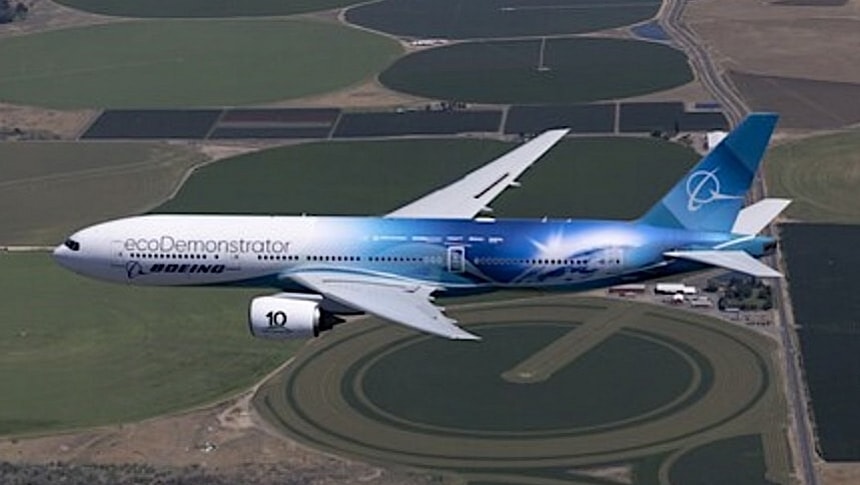The many current projects meant to make aircraft engines and designs more fuel-efficient and eco-friendly steal the headlines on a regular basis these days, and for good reason. Just think about it: how often to we get to see radically different types of aircraft bodies and engines come into this world?
But an aircraft is more than just a cylinder with wings and engines attached to them, so if we really plan to make significant changes across the board, research must go much deeper than that. And that's exactly what American aerospace giant Boeing is doing with a program called called ecoDemonstrator.
The effort began over at Boeing back in 2012 with the goal of "taking promising technologies out of the lab and testing them in an operational environment to solve real-world challenges for airlines, passengers and the environment."
To date, 11 different planes have been used to put some 250 ideas through their paces, including a 737-10 that, at the end of last year, alternatively burned sustainable aviation fuel and conventional fuel to understand the effects of SAF on contrails.
While we're still waiting for the results of those tests, Boeing announced the most recent addition to the ecoDemonstrator fleet: a 777-200 Extended Range that will be used as a testbed for at least 19 different technologies. These technologies target different aspects of an aircraft's operation.
In and around airports, for instance, Boeing will examine how single-engine taxis and digital taxi clearances can reduce fuel consumption and reduce pilot workload. Then, it will look into how steeper glide slopes and continuous descent approaches could be used to reduce not only fuel consumption, but also noise.
Boeing says "one of the most challenging parts of recycling an airplane" comes in the form of aircraft interiors. So the American giant will look into the use of lighter and recyclable floor coverings, but also recycled carbon fiber ceiling panels.
To make the plane's cabin lighter and less noisy, the company will also test cabin insulation made of fabric-covered acoustic panels for the bulkhead and galley.
As far as the seats themselves are concerned, Boeing is looking to fit the ones in economy and business classes with sensors that can determine if a person is seated at crucial points during the flight.
Boeing says this year's 777-200ER ecoDemonstrator will take flight in the coming months, but we're not told anything about when to expect the first results of the tests.
This variant of the 777 has been around since the mid-1990s, and managed to set the great circle distance without landing record for an airliner, flying without interruption from Seattle to Kuala Lumpur, Malaysia. That's a distance of 11,814.90 miles (19,014.31 km), something no other plane had achieved by that point in 1997.
The effort began over at Boeing back in 2012 with the goal of "taking promising technologies out of the lab and testing them in an operational environment to solve real-world challenges for airlines, passengers and the environment."
To date, 11 different planes have been used to put some 250 ideas through their paces, including a 737-10 that, at the end of last year, alternatively burned sustainable aviation fuel and conventional fuel to understand the effects of SAF on contrails.
While we're still waiting for the results of those tests, Boeing announced the most recent addition to the ecoDemonstrator fleet: a 777-200 Extended Range that will be used as a testbed for at least 19 different technologies. These technologies target different aspects of an aircraft's operation.
In and around airports, for instance, Boeing will examine how single-engine taxis and digital taxi clearances can reduce fuel consumption and reduce pilot workload. Then, it will look into how steeper glide slopes and continuous descent approaches could be used to reduce not only fuel consumption, but also noise.
Boeing says "one of the most challenging parts of recycling an airplane" comes in the form of aircraft interiors. So the American giant will look into the use of lighter and recyclable floor coverings, but also recycled carbon fiber ceiling panels.
To make the plane's cabin lighter and less noisy, the company will also test cabin insulation made of fabric-covered acoustic panels for the bulkhead and galley.
As far as the seats themselves are concerned, Boeing is looking to fit the ones in economy and business classes with sensors that can determine if a person is seated at crucial points during the flight.
Boeing says this year's 777-200ER ecoDemonstrator will take flight in the coming months, but we're not told anything about when to expect the first results of the tests.
This variant of the 777 has been around since the mid-1990s, and managed to set the great circle distance without landing record for an airliner, flying without interruption from Seattle to Kuala Lumpur, Malaysia. That's a distance of 11,814.90 miles (19,014.31 km), something no other plane had achieved by that point in 1997.









